|
In the lands of the Bisclavret, along the banks of the Skirfane River dwell a minor
house known as the Repense -- a diminishing bat nobility reigning from their observatory
towers over a domain populated primarily by mice. Among the Repense nobility, it is a
long-standing tradition to study the heavens, and to discern portents amongst the stars
and wandering bodies, and thus to determine the best way to go about one's life.
Because of their dedication to the study of the stars, House Repense has produced the
most comprehensive and accurate star atlases to be found in all Calabria. Whether one's
interest is in divination or navigation by the stars, no better star chart will be found
than one from the star-gazing bats and their mouse assistants.
The Constellations
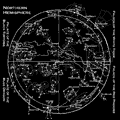 There are far too many stars for any one person to know them all by name (though some
Repense do a commendable job of knowing all the brightest ones). Rather, they are
grouped together in groups called constellations. It is imagined that these grouping
of stars, if connected together, form crude images in the heavens. Some are much easier
to find than others, owing to especially bright stars, or distinctive groupings.
There are far too many stars for any one person to know them all by name (though some
Repense do a commendable job of knowing all the brightest ones). Rather, they are
grouped together in groups called constellations. It is imagined that these grouping
of stars, if connected together, form crude images in the heavens. Some are much easier
to find than others, owing to especially bright stars, or distinctive groupings.
Within Calabria, there is no absolute standard as to how the stars are to be seen -- and
even if the general names are accepted, there is a tendency to exercise some discretion
in how to depict the constellations. For example, "The King" in Bisclavret lands will most
assuredly be a wolf. A star atlas crafted in Doloreaux lands -- if it even follows the
Repense naming conventions at all -- will portray a boar seated on the throne.
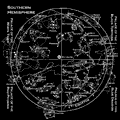 Throughout the night, the stars seem to rotate against the black dome of the sky. Exactly
which constellations are visible in the sky will vary depending upon the time of year and
the latitude of the observer. As the sun makes its progression along the Plane of the
Ecliptic, those constellations near its position will not be visible -- because they would
only be in the sky during the daytime, when stars cannot be seen! Also, those
constellations closest to the south pole are not visible in northern Calabria -- though
Repense charts still show some of them, thanks to observations gained from forays into
southern oceans.
Throughout the night, the stars seem to rotate against the black dome of the sky. Exactly
which constellations are visible in the sky will vary depending upon the time of year and
the latitude of the observer. As the sun makes its progression along the Plane of the
Ecliptic, those constellations near its position will not be visible -- because they would
only be in the sky during the daytime, when stars cannot be seen! Also, those
constellations closest to the south pole are not visible in northern Calabria -- though
Repense charts still show some of them, thanks to observations gained from forays into
southern oceans.
|
The Repense Zodiac
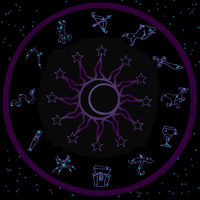 Twelve constellations lie along an imaginary line in the sky that describes the
Plane of the Ecliptic, along which the "wandering bodies" (planets) and the sun
move. These constellations are especially significant to the Repense for purposes
of divination, and considerable importance is placed upon what constellation the sun
was passing through at the time of one's birth.
Twelve constellations lie along an imaginary line in the sky that describes the
Plane of the Ecliptic, along which the "wandering bodies" (planets) and the sun
move. These constellations are especially significant to the Repense for purposes
of divination, and considerable importance is placed upon what constellation the sun
was passing through at the time of one's birth.
The twelve constellations of the Zodiac consist of (Northern
Hemisphere) the Fish, the Sword, the Destrier, the Chalice, the Natheireun, the
Coffer, and (Southern Hemisphere) the Spider, the Scepter, the Serpent, the Scythe,
the Comhach, the Bow.
| |
The Five Wanderers
 Most stars stay in their appointed positions in the heavens. However, there are five
"stars" that refuse to stay in place, and which travel along the Plane of the Ecliptic.
These are known as the Wanderers (alternately known as the Planets).
Their convergence with prominent constellations is often held to have great import for
horoscopes and general divination. The Wanderers include:
Most stars stay in their appointed positions in the heavens. However, there are five
"stars" that refuse to stay in place, and which travel along the Plane of the Ecliptic.
These are known as the Wanderers (alternately known as the Planets).
Their convergence with prominent constellations is often held to have great import for
horoscopes and general divination. The Wanderers include:
St. Bragnaine, the Mouse Star: messenger of the heavens.
St. Wynne, the Doe Star: water-bearer of the heavens.
St. Weylyn, the Wolf Star: huntsman of the heavens.
St. Trahern, the Bear Star: smith of the heavens.
St. Condan, the Cougar Star: architect and artist of the heavens.
|
Major Constellations of the Northern Hemisphere
 All of the constellations in the northern hemisphere are clearly visible within all of
Calabria during at least part of the year. The single most distinctive star (if not
necessarily the brightest or easiest to find) is Azzis, the Axis Star, also known as the
North Star, which is located directly above the north pole. (Please note that even if
astronomers of the present area in Calabria recognize a point of rotation of the heavens,
that doesn't mean that everyone accepts that the world is round!)
All of the constellations in the northern hemisphere are clearly visible within all of
Calabria during at least part of the year. The single most distinctive star (if not
necessarily the brightest or easiest to find) is Azzis, the Axis Star, also known as the
North Star, which is located directly above the north pole. (Please note that even if
astronomers of the present area in Calabria recognize a point of rotation of the heavens,
that doesn't mean that everyone accepts that the world is round!)
The Axis Star is of great importance to navigators, because it provides not only a sure
way to determine true north, but a relatively easy standard by which to determine one's
approximate latitude. A navigator may use a quadrant to determine the star's altitude
(in degrees) above the horizon at sea. This measurement in degrees happens to be
approximately equal to the observer's latitude in degrees north of the equator. (i.e.,
if the observer were standing on the equator, the Axis Star would be dead on the horizon,
or 0 degrees from the horizon. If the observer were standing on the north pole, the
Axis Star would be directly overhead, or 90 degrees from the horizon.)
Alas, the Axis Star is not visible from positions in the southern hemisphere.
|
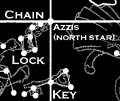 Chain and Lock
Chain and Lock
The end of the chain includes Azzis, the Axis Star, also known as the North Star.
Key
This cluster of six stars is easily located by novice stargazers, and the two stars
that compose the ring can be used to find Azzis by following the line they form.
|
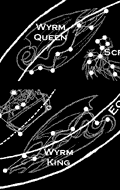 The Wyrms
The Wyrms
The Wyrm King and Wyrm Queen are two clusters of stars close to the equator (but still
mostly in the northern hemisphere) that look very like each other, and can be confusing
to novice stargazers. The Wyrm King is located near the Coffer, whereas the Wyrm
Queen's head points to the Bow. In myth, wyrms are fire-breathing reptiles, not to
be confused with the dragons of Zhongguo (though that is not to say that no one ever
does).
|
 Knight and Monsters
Knight and Monsters
The Knight ("Cuirassier") is located far north, and the stars that compose the main
"square" of its torso are easily picked out. In illuminated star atlases, the
species of the Knight varies greatly, depending upon the region in which the atlas was
made (and its intended audience), but the Repense depict this as a horse of Avoirdupois,
driving off the serpentine Daemon ("Naga"), the Sea Monster ("Kraken"), and the Great
Beast.
Riddock's Tower
Crossing the "Spilled Wine" is the constellation of Riddock's Tower. Originally, the
Repense imagined this tower to be a celestial echo of one of their own astrological
towers, and the "Spilled Wine" here a stellar companion to the River Skirfane. In
modern times the tower has been renamed to honor their Bisclavret masters.
The Ladies
Watching the exploits of the Knight are the Lady and Helloise. Originally, these
constellations represented the old goddesses: Reina and Adriene, respectively. (Reina
was Goddess of the Day, and Queen of the Gods, whereas Adriene was her charming but
subversive sister Adriene, Goddess of the Night.) With the advent of the worship of
S'allumer, star atlases replace Adriene with a depiction of Helloise holding a child in
her arms, and Reina with a noblewoman (changing her scepter into a small telescope).
|
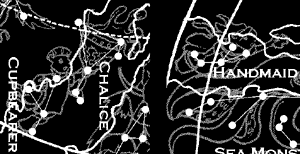 The Mouse Servants
The Mouse Servants
Lancelin and Ancelin in myth were brother and sister mice who were gifted with
legendary good looks, and were taken to the heavens to serve the gods. Choosing them on
the basis of good looks, however, was not the best of decisions.
Lancelin, tasked with being cupbearer to the gods, spilled the Ever-Full Chalice. The
constellation of the Chalice appears to be upended to anyone viewing it while looking
northward, as held by Lancelin (the Cupbearer), with the misty expanse of the "Spilled
Wine" coming forth from it. Ancelin, the Handmaid, is on the opposite end of the sky,
forever tasked with cleaning up the mess, lest it engulf the entire heavens. In the
modern interpretation, Ancelin and Lancelin are servants of Heaven, though Lancelin's
failure and Ancelin's diligence are given a moralistic spin.
|
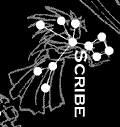 The Scribe
The Scribe
Atop Riddock's Tower, a porcupine Scribe of House Esclage dutifully records all of
history in a tome, as she observes it from the heavens. (In the oldest atlases,
the "spines" of the porcupine formed wings, and the scribe was depicted as a bat
skygazer atop the tower.)
|
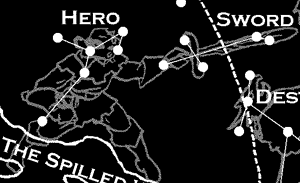 The Hero
The Hero
The Hero, depicted as a badger woodsman of House Blaireu, takes the Sword in hand,
doing battle against the Giant and his Mastiff. In the earliest star atlases, this
wasn't a Hero at all, but rather a constellation known as the Herald, depicted as a
mouse holding a horn. Its close proximity to the Sword, combined with political
reasons, prompted the transformation.
|
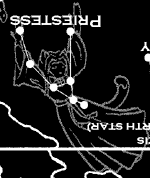 The Priestess
The Priestess
The Priestess is depicted as a Penitant of S'allumer, and on all Repense charts, she
is shown as a cat. In pagan times, this constellation was known as Sybilia, the
Prophetess. Long ago, there developed a belief among the Repense that certain young
girls of spotted varieties of the Screeberagh were "marked of the stars" and were
gifted with a certain wild intuition on matters of fate. (Such a girl was considered
"marked of the stars," and thus a potential "wild prophetess" if a few spots on her
coat happened to roughly suggest some constellation of stars.)
Their role as prophetesses boiled down to a matter of a "random
decision maker": if an astrologer had more than one possible interpretation to make of
an omen, he might consult a Screeberagh prophetess to choose between his options,
without giving her any information about the implications of the choices. (The rest of
the time, a Screeberagh "prophetess" just served as yet another servant in the house of
the Repense nobility.)
|
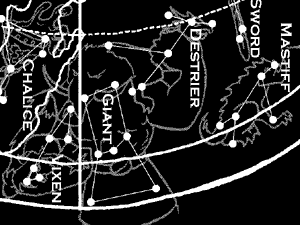 The Giant
The Giant
The core stars comprising the "Giant" don't really describe a figure large enough to
warrant its name. However, in many star atlases, the "Giant" is depicted in such a way
as to engulf several nearby constellations, and to incorporate a number of fainter stars,
giving it a size more worthy in its reputation. In either case, the three stars
comprising the Giant's Belt are easily picked out, making this a commonly known
constellation.
In the greater Giant constellation, the Destrier is held
aloft in the Giant's left arm, with the Vixen held in his right. (Some of the stars
comprising his legs overlap those of the Unicorn.) Running ahead of the Giant is his
hunting beast, the Mastiff.
The Giant is portrayed as a huge man with features very reminiscent of elephants of
Yindu, though possessing enormous tusks and a hairy body. This image is inspired by
wild old sailors' tales of an "isle of demons" in the frigid northern waters, populated
by man-eating monsters described with such features.
|
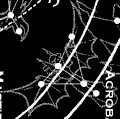 The Acrobat
The Acrobat
Perhaps more accurately termed an "aerobat," this constellation portrays a bat
performer gleefully soaring through the air to entertain the host of heaven (or
the old gods, in pagan times).
|
|
Major Constellations of the Southern Hemisphere
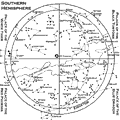 Most if not all of the constellations in the southern hemisphere are visible
from Calabria. Those far south enough not to be visible from the towers of the
Repense are known only thanks to journeys into the southern seas, and careful
measurements taken by astronomers there.
Most if not all of the constellations in the southern hemisphere are visible
from Calabria. Those far south enough not to be visible from the towers of the
Repense are known only thanks to journeys into the southern seas, and careful
measurements taken by astronomers there.
Unfortunately, just as the southernmost constellations are not visible in the north,
so the northernmost constellations are not visible in the south, including Azzis, the
Axis Star. The southern hemisphere lacks any equivalent South Star, or even one
sufficiently close to serve as an estimate.
|
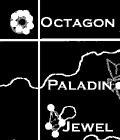 Octagon and Jewel
Octagon and Jewel
There is no "Southern Star," but for sailors who travel the southern seas, there are two
constellations not visible in the northern hemisphere that help to find which way true
south is.
When it is visible (which is only about half of the year in many latitudes) a ring of
eight bright and closely clustered stars can be seen very close to -- but not quite at
-- the southern axis. Religious-minded cartographers portray this constellation as a
perfect circle with the octagram of the S'allumer faith inscribed within it, though the
actual cluster is somewhat irregular in shape. Another constellation that serves as a
sort of compass in the southern hemisphere is Gemma, the Jewel. The two stars that form
the vertical axis of this "diamond" make a line that points due south; it is roughly
opposite the Octagon, and hence is useful as a guide to sailors during the months when
the Octagon is not visible.
|
 The Paladin
The Paladin
This is a relatively new addition to the star atlases, as in ancient charts, these stars
were not considered bright enough (positioned as they are against the hazy stream of the
Spilled Wine) to warrant a constellation of their own. Many
star atlases made outside Repense lands don't even bother to include this one, but it's
officially portrayed -- in a tip of the hat to their religious and political masters --
as a wolf holding a calendar sword, and wearing a tartan of Bisclavret nobility.
|
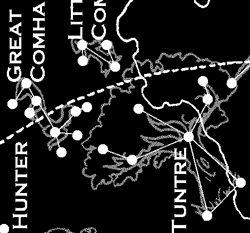 The Tuntre and the Comhaches
The Tuntre and the Comhaches
The Tuntre is an allusion to an old tradition that actually started with the old Phelan
(before the emergence of the Bisclavret): when the first master of a farm died, he was
buried in the yard of the homestead, and a rowan tree was planted over his grave. This
tree was known as a "tuntre," and the farmer's descendants would make prayers at this
tree, believing that it held the spirit of their ancestor -- who would guard the farmstead
and bless the crops. Although the original pagan connotations have gone away, the
practice of planting a single "yard tree" next to the homestead is still followed --
without, necessarily, anyone buried underneath it.
Typically portrayed as frolicking amongst the boughs are the Comhaches -- the Greater
Comhach is a constellation in the Zodiac, though sometimes its companion "Lesser Comhach"
is included with it. ("Comhach" is a general term originating with the Phelan that refers
to a wide number of small lizard pests, but to the Repense it is most strongly associated
with a specific variety of tree-dwelling "little thieves.")
|
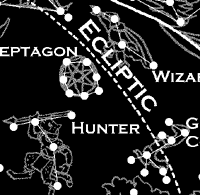 The Septagon
The Septagon
This is a cluster of seven stars located close to the Plane of the Ecliptic, often left out
as a constellation from star atlases. When it is depicted, the Septagon sometimes is
shown with a seven-pointed star inscribed upon it, making it more properly termed a
Septagram. This constellation has sinister connotations in divination, borrowing
from the lore of Septagus, Lord of Misrule, from the Doloreaux.
The Wizard and the Hunter
The Repense see these two constellations, each flanking the "sinister" section of the
Ecliptic Plane, as representing a sort of opposition -- the refinement and education
represented by the Wizard (depicted traditionally as a ferret for unknown reasons)
compared to the noble savagery of the Hunter (depicted traditionally as a cheetah spearman
from Akoma).
|
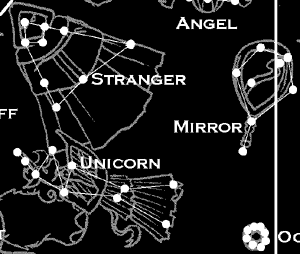 The Court of Mystery
The Court of Mystery
This cluster of constellations once served other roles as minor deities in the Repense
pantheon. The Stranger is shown as a cowled and cloaked stranger of deliberately
indeterminate species, and was once identified with Somner, mysterious attendant to
Syphus, the Riddling God. The Mirror is depicted as a hand-mirror -- attribute of
Maurelle, Goddess of Beauty, though now its pagan significance is all but forgotten.
Nearby is Anasa, Queen of Unicorns, playing a harp. (In Repense myth, unicorns are
faerie creatures, living in the realm of Arcadia -- a primordial forest physically
located on the far side of the moon, but magically connecting with the earthly realm
now and again during full moons combined with planetary conjunctions. It is believed
that they are pure, nearly angelic beings whose horns possess the power to purify water
or negate all manner of poisons - but that the touch of iron burns them.)
|
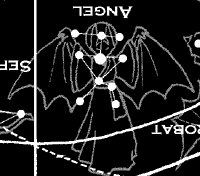 Syphus, the Angel
Syphus, the Angel
Syphus the Angel is seen by the Repense as a messenger of the Light, who brings omens
to mortals in cryptic and riddling ways, so that they might be enlightened only through
diligent study and reasoning. In ancient times, before the rise of the Rinaldi and the
faith of S'allumer, Syphus was the God of Riddles to the Repense, responsible for
arranging the stars in the heavens, and directing the movements of the planets, for the
purpose of hiding secrets that might be found only by those diligent enough -- and thus
worthy -- to find them.
|
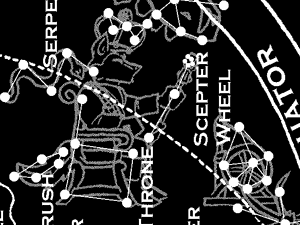 The King's Court
The King's Court
The meta-constellation of the King is composed of the easily found Throne (easy because
the main square is composed of four fairly bright stars), the Scepter (a zodiac
constellation on the Ecliptic), the Crown, and the Tail-Brush. Before the King, the
Spider weaves gold on a magical Spinning Wheel.
The identity of the King as portrayed in star atlases varies greatly depending on who
is making the chart. Originally, in the oldest Repense star atlases, there was a bat
god (Audric, King of the Gods) on the throne, with some of the stars of the Serpent
serving for wings. Behind the throne was the constellation of Padgett, the Page, a mouse
attendant.
With the rise of the Rinaldi and their conquest of Repense lands, the Page became a
Tail-Brush for a fox king sitting on the throne. When the Rinaldi began to decline, and
the Repense had new masters in the Bisclavret, the King became a wolf.
|
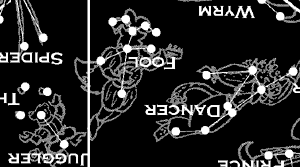 The Performers
The Performers
Sometimes thematically joined with the Unicorn and Acrobat, these three constellations
represent entertainers: the Fool (often shown as a very foppish fox jester playing a
lute), the Juggler (shown as a monkey in courtier garb, with three of the stars
being three golden balls he juggles), and the Dancer (typically a Screeberagh
servant, or else an Akoman cheetah slave).
|
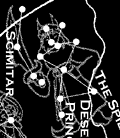 The Desert Prince
The Desert Prince
This constellation is traditionally depicted as a tuft-earred desert lynx.
The Desert Prince hefts an enormous curved blade described by the companion
constellation of the Scimitar.
|
|
The Four Guardians of the Heavens
Of course, the same stars shine in the night sky over distant Zhongguo as over
Calabria, though they are known by different names. They still divide up the stars into
constellations, though different ones. They recognize the utility of the North Star, and
to them the Key is known as the "Six Northern Stars." However, they organize the heavens
differently, dividing them up into four quarters known as Palaces, and with
twenty-eight small constellations (seven for each Palace) that are known as "Moon Lodges".
For purposes of divination, the positions of the planets and stars are important, but so
too is that of the moon. Its position is measured by determining which "Moon Lodge"
constellation it is closest to. Seven Moon Lodges join together to form a larger
meta-constellation, each one associated with one of the Four Heavenly Guardians, of the
Four Heavenly Palaces. Each Guardian is associated with a cardinal direction, a Daoist
element, a color, and a season of the year.
Each season, one of these Palaces is considered prominent in the heavens. A cardinal
direction is associated with each Palace, based on which way the shaft of the Six Northern
Stars is pointing when that Palace is prominent.
The Stars point north (down) in winter, east in spring, south (up) in summer, and west
in autumn. (This alignment isn't perfect ... but astrology is not an exact science, as
much as sky-gazers would sometimes like to convince the layman otherwise.)
|
The Black Tortoise of the North
The Black Tortoise is depicted as a strange sea creature that is part
tortoise, part serpent. The Black Tortoise is associated with the Daoist element of
Water, and with the season of winter.
|
The Blue Dragon of the East
The Blue Dragon (sometimes Green Dragon) is associated with the
Daoist element of Wood, and with the season of spring.
|
The Red Phoenix of the South
The Red Phoenix is associated with the Daoist element of Fire, and with the season
of summer.
|
The White Tiger of the West
The White Tiger is associated with the Daoist element of Metal, and with the
season of autumn.
|
The Golden Qi-Ling of the Center
This is a less recognized "constellation," rarely shown on star atlases, that
includes the North Star and the Six Northern Stars. The Qi-Ling has no Moon Lodges,
Palace or season associated with it, but occupies the symbolic direction of the "center,"
and is associated with the remaining Daoist element of Earth.
|
|


